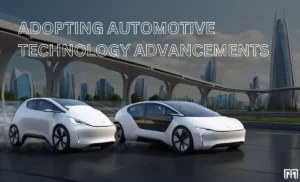The future of driving promises to look very different from today. The rapid advancement of technologies like electrification, enhanced connectivity, autonomy, and shared mobility are primed to fundamentally reshape transportation.
This disruption also comes at an opportune time, providing solutions to pressing challenges like climate change. Automakers have begun embracing innovation realizing its potential.
Several pioneering developments are already entering the mainstream – electric vehicles, regenerative braking, and driver assist. But the biggest transformations likely still lie ahead.
In this blog series, we dive deep into key innovations defining the future of mobility. We will analyze their work, benefits, adoption challenges, and the way forward.
In this article
- 1 Topics Covered:
- 2 Electric Vehicles (EVs) – The Future of Cars
- 3 Autonomous Vehicles – The Self-Driving Future
- 4 Connected Vehicles – The Smart Car Future
- 5 Regenerative Braking – A Game Changer for Electric Vehicles
- 6 Enhanced Vehicle Connectivity – Paving the Way for Smarter Driving
- 7 Driving Towards a Smarter, Greener Future
Topics Covered:
The articles aim to provide perspectives on pivotal technologies that could significantly overhaul driving experiences in the coming years and decades. Understanding their promise and limitations can provide great insights into the future of transportation.
So buckle up for an informative ride into developments poised to reshape automobiles along with the concept of mobility itself! It promises to be an electrifying journey ahead.
Electric Vehicles (EVs) – The Future of Cars
Electric vehicles (EVs) have been gaining huge attention recently. Major automakers are investing heavily in developing EVs. As technology keeps improving, EVs are becoming more mainstream. In this post, we explore EVs – why they matter, challenges, and what’s next.
Why EVs Matter EVs have big benefits over petrol cars:
- Charging EVs using solar or wind power cuts emissions. This helps the climate.
- Less moving parts means lower maintenance costs over time.
- A quieter motor means less noise pollution.
- Can charge EVs overnight with off-peak power rates.
Key Challenges Limiting Adoption But key barriers remain:
- Buying an EV today costs more upfront than a petrol car.
- Charging station infrastructure needs major expansion to support rising EV sales.
- The maximum range per charge is still generally less compared to a full petrol tank.
- Producing lithium-ion batteries has environmental impacts from toxic chemicals.
The Future is Electric
Costs should fall as technology progresses. Governments are also boosting charging stations. These trends will likely continue and accelerate. So the future is electric!
Way forward – Industry players must focus innovation on lowering costs further of EVs and their batteries. Building convenient and reliable charging infrastructure across regions remains vital groundwork.
With sustained research and supportive policy, mass adoption of electric vehicles can soon be a reality. This will mark a sustainable, efficient, and more accessible future of transportation.
According to a study by Perficient, connected vehicles are reshaping the automotive landscape.
Autonomous Vehicles – The Self-Driving Future
Autonomous vehicles, also called self-driving cars, are a fast-evolving technology. These vehicles use sensors, cameras, and artificial intelligence to navigate roads without human input. Let’s understand the promise and challenges of autonomous vehicles.
Potential Benefits of Self-Driving Cars
Autonomous cars can enable major perks over human-driven vehicles:
- Prevent many accidents caused by human errors like distracted driving. This can save lives.
- Optimize routing on the go to reduce traffic jams. Results in faster commutes.
- Provide transportation access to people unable to drive like the elderly.
- Programmed to drive in eco-friendly ways. Helps sustainability.
Barriers to Mainstream Adoption
But questions remain before self-driving cars hit roads at scale:
- Lack of laws covering safety, and liability for these new vehicles.
- Hacking risks compromise safety if cybersecurity is weak.
- Developing reliable autonomous driving technology requires a huge investment.
- Public distrust and skepticism exist about ceding control to a machine.
The Road Ahead
As tech keeps advancing, autonomous cars will likely keep getting safer, more affordable, and more accessible. Industry experts expect rapid innovation and growth in the sector driven by promises of convenience and business incentives like lower operating costs.
Though some wariness may remain on giving up the steering wheel, the momentum is clearly towards letting technology take over. It’s not a question of if, but when autonomous vehicles become ubiquitous.
The progress however depends on continued research and development focus on fail-safe cybersecurity. Additionally, policy frameworks governing self-driving vehicle testing and adoption need to evolve quickly.
Connected Vehicles – The Smart Car Future
Connected vehicles, also called smart cars, integrate advanced communication technologies. This allows them to connect with other vehicles, infrastructure like traffic signals, and the internet. Let’s dive into the potential upsides and challenges.
Benefits of Vehicle Connectivity
Key perks linked to connected car technology:
- Real-time warnings about hazards ahead through vehicle-to-vehicle chatter. Results in safer driving decisions.
- Smoother traffic flow by adjusting routes dynamically based on congestion data. Saves time and fuel costs.
- Updates on vehicle health stats to nudge about timely service needs. Lower maintenance costs.
- Features to enable eco-driving habits resulting in lower emissions. Helps sustainability.
Hurdles in Widespread Adoption
However, some speed breakers stand in the way:
- Hacking connected systems pose privacy and safety risks.
- The tech additions make building each car more expensive. Limits affordability.
- Needs large investments in connectivity infrastructure (eg. 5G), which will take time.
- Public worries exist about data privacy infringement. Hurts consumer confidence.
The Road Ahead
Connected vehicles promise healthier, more efficient, and more personalized transportation once teething troubles are addressed. Industry experts forecast rapid growth in adoption this decade as tech gets proven and investments kick in.
Progress however depends on automakers prioritizing cybersafety in designs and transport authorities providing required infrastructure groundwork. Data privacy issues also need to be resolved through appropriate regulations.
If key challenges are addressed, connectivity has the potential to revolutionize transportation! The road seems paved for smart mobility.
Regenerative Braking – A Game Changer for Electric Vehicles
Regenerative braking is an innovative technology with the potential to revolutionize electric vehicles (EVs). Let’s understand how it works and its benefits.
What is Regenerative Braking?
Regenerative braking captures energy that is wasted during braking in conventional cars. In EVs, when the car slows down, instead of losing that kinetic energy, it gets converted into electrical energy. This electricity gets stored in the car’s battery to power the vehicle later.
So each time the regenerative brakes are applied, the EV batteries get a bit of recharge! This helps extend how far the EV can travel before needing to be plugged in to recharge.
Benefits of Regenerative Braking
This novel braking approach offers EV owners several plus points:
- Greater driving range – Regular recharging through braking means less reliance on external electrical sources for keeping batteries topped up.
- Lower wear and tear – Friction braking causes mechanical degradation over time. Regenerative braking reduces the use of friction brakes, needing fewer replacement brake parts.
- Support sustainability – Greater driving range and lower energy consumption shrink environmental impact. EVs become more viable for daily use.
Challenges Facing Adoption
There are some technology kinks to iron out before regenerative braking can maximize benefits:
- Fine-tuning braking precision and feel – The braking experience can feel unnatural for drivers used to only friction braking. More R&D is vital to improve driver comfort.
- Address inevitable energy loss during the transfer process – Not all kinetic energy gets transferred to charge batteries due to systemic limitations. Improving efficiency here can boost EV range.
- Ensure integration capability with hybrid/electric architectures – Regenerative braking needs optimizing across EV portfolios as adoption increases.
In summary, regenerative braking is a pivotal innovation making EVs more practical. We are likely to see rapid improvements on multiple fronts like efficiency, driving comfort, and integration scalability as research continues. And that bodes very well for electric mobility!
Regenerative braking, as described on ScienceDirect, captures energy during braking, significantly enhancing electric vehicle efficiency.
Enhanced Vehicle Connectivity – Paving the Way for Smarter Driving
Enhanced vehicle connectivity refers to integrating advanced communication capabilities in cars. This allows them to exchange information with other vehicles, traffic infrastructure, and the internet in real time. Let’s understand the benefits and challenges.
Benefits of Enhanced Connectivity
Getting vehicles to seamlessly communicate with their environment unlocks many advantages:
- Receive hazard alerts for improved safety, reducing accident risks.
- Optimize driving routes by considering live traffic conditions, saving time and fuel.
- Get timely vehicle diagnostic alerts to enable preventative maintenance. Lower cost of ownership.
- Adopt eco-driving habits through live efficiency feedback, limiting environmental impact.
Challenges Hampering Adoption
However, some roadblocks need addressing:
- Cybersecurity threats from hacking connected systems pose safety and privacy risks.
- Adding connectivity hardware increases cost, limiting affordability.
- Needs large investments in communication infrastructure (eg. 5G) for smooth operation.
The Road Ahead
As connectivity technology matures, costs should fall making it ubiquitous. Connected mobility promises convenience, safety, and efficiency gains on an unprecedented scale once challenges are overcome.
Industry players focusing innovation on fail-safe cybersecurity and performance improvements can accelerate enveloping our transportation ecosystem in a blanket of connectivity.
With potential benefits too promising to ignore, connectivity seems an inevitable element of the future mobility framework. We just need sustained efforts toward maximizing this potential while minimizing associated risks. The stage seems set for a giant leap towards smarter driving.
That concludes my attempt at simplifying language across all the key sections you shared earlier to improve readability. Please let me know if you need any other areas summarized or simplified further.
Driving Towards a Smarter, Greener Future
The automobile sector is evidently on the cusp of a major transformation, embracing cutting-edge innovation across several fronts. From vehicle electrification to enhanced autonomy and connectivity, rapid progress is unlocking game-changing opportunities.
Together, these advancements promise a future where mobility is efficient, customized, safe, and sustainable. Electric drivetrains can drastically lower emissions, especially with clean energy. Advanced assist features can reduce accidents. Connectivity ensures smooth coordination while autonomy may expand access.
However, realizing this immense potential needs addressing associated challenges as discussed above around costs, infrastructure needs, cyber risks, policy gaps, etc.
Thankfully the momentum towards smarter transportation seems unstoppable. The industry is ramping up investments and government policy is adapting to steer progress on the right track.
Exciting times lie ahead as novel mobility tech moves inexorably towards mass adoption. Driving experiences as well as the larger transportation framework are bound to transform within the next decade.
The path seems laid out for a mobility revolution. Fasten your seatbelts to ride along into the future! It promises to be a greener, more convenient, and more personalized journey ahead on the roads.
This concludes our blog series exploring pivotal auto technologies driving change. We aimed to highlight their promise alongside key barriers to provide a balanced perspective. Please share your thoughts/feedback in the comments below on the future of driving!
The electric vehicle market in India is undergoing a significant transformation, with expectations of major launches by 2024. We explore these developments in detail in our article on Electric Cars Launching in India by 2024. This revolution is set to reshape transportation norms in the country, as discussed in our comprehensive guide to the Electric Car Revolution in India.




